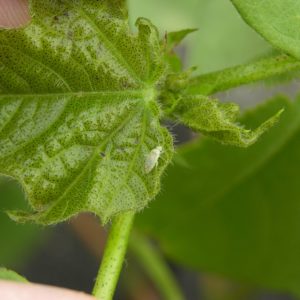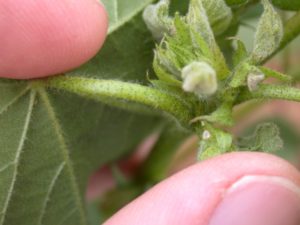 Most cotton fields are squaring so the cotton fleahopper is the primary pest of interest in these fields. I use an economic threshold of 15 cotton fleahoppers per 100 plants. Adults and nymphs count the same.
Most cotton fields are squaring so the cotton fleahopper is the primary pest of interest in these fields. I use an economic threshold of 15 cotton fleahoppers per 100 plants. Adults and nymphs count the same.
The cotton fleahopper will feed on the soft plant parts in the terminal of the plant. They cause injury when they feed on small squares causing the square to be “blasted” and then abscise, or fall off the plant. Once a square is larger than a pin head, it is considered safe from cotton fleahopper feeding.
The square loss associated with cotton fleahopper feeding can cause yield loss and delayed maturity in the crop. The cotton plants can often compensate from lower amounts of fruit loss by retaining other squares. While the fruit compensation may prevent yield loss, it will usually result in delayed maturity.
Some of my field trials have found percent open counts to be 5-25% lower in untreated plots with higher populations of cotton fleahoppers. The delay in boll opening can result in up to 7-10 days delay in harvest.
The dry conditions may encourage some growers to delay treating for cotton fleahopper as a means of reducing input costs. I would caution against this delay.
Research on fruit compensation has demonstrated that lower yielding cotton fields have less ability to compensate for fruit losses. Thus, it may be more important to control fleahoppers in fields with cotton yield potential of 700 lbs or less than in fields expected to yield over 2 bales.
Our IPM Extension Agent in The Rio Grande Valley, Danielle Sekula, has been seeing cotton aphid in most of the fields down there. You can read more in Danielle’s Pest Cast here: https://southtexas.tamu.edu/programs-and-services/ipm/
Keep an eye on aphid numbers. If you find parts of a field with aphids, wait 2-3 days and check that area again to see if the aphid numbers are increasing or falling.
In this picture, the large white insects are Scymnus Lady Beetle Larvae which are eating aphids. The small white “flakes” are aphid exoskeletons, or cast skins from molting.
Field Meetings
Cotton Scouting Field Meeting: Monday, May 9, 8:30 am. FM 1679, 1/2 mile South of Sanders Rd.
Refugio County Crop Tour: June 8, Bonnieview
Victoria County Crop Tour: June 14, 8 am at Dacosta Hall
Calhoun County Crop Tour: June 14, 3:30 pm at Auditorium in Ag Building
Audio Updates
We are recording pest updates in effort to provide a brief audio version of South Texas newsletters and blog posts. The reports include crop production and pest management updated from South Texas, including the Rio Grande Valley, Coastal Bend and Mid-Coast.
You can get these by following this link: https://www.texasinsects.org/south-texas.html
Use this link for all IPM Audio Updates: https://www.texasinsects.org/agriculture-audio-updates-home.html


